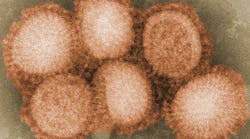How to deal with infectious diseases in the dental office: Stay alive by getting a flu vaccination!
H1N1 Virus Exposures to 2009 H1N1 influenza virus occurs in household, community, and occupational settings, and transmission is thought to occur through droplet exposure of mucosal surfaces; through indirect contact, usually via the hands, with respiratory secretions from an infectious patient or contaminated surface; and through inhalation of small particle aerosols in the vicinity of the infectious individual.(2) Persons with influenza, including 2009 H1N1 influenza, may have some or all of these symptoms: • fever* • cough • sore throat • runny or stuffy nose • body aches • headache • chills • fatigue • sometimes diarrhea and vomiting *It’s important to note that not everyone with influenza will have a fever.(2) So how do we control the spread of this virus in the dental office? Here are some controls that should be in place: 1. Elimination of potential exposures (e.g., deferral of ill patients and source control by masking coughing individuals). 2. Engineering controls that reduce or eliminate exposure at the source without placing primary responsibility of implementation on individual employees. 3. Administrative controls including sick-leave policies and vaccination that depend on consistent implementation by management and employees. 4. Personal protective equipment (PPE) for exposures that cannot otherwise be eliminated or controlled. PPE includes gloves, surgical facemasks, respirators, protective eyewear, and protective clothing (e.g., gowns).Vaccination, an administrative control, is one of the most important interventions for preventing transmission of influenza to health care personnel. For more information on this hierarchy of controls, see Centers for Disease Control and Prevention (CDC’s) Interim Guidance on Infection Control Measures for 2009 H1N1 Influenza in Healthcare Settings, Including Protection of Healthcare Personnel (see link on final page).(2) For Specific Recommendations for Dental Health Care, visit the website.(2)
On December 24, 2013, the CDC issued an emergency advisory, Notice to Clinicians: Early Reports of pH1N1-Associated Illnesses for the 2013-14 Influenza Season.(9)Part of the summary is as follows:
“From November through December 2013, CDC has received a number of reports of severe respiratory illness among young and middle-aged adults, many of whom were infected with influenza A (H1N1) pdm09 (pH1N1) virus. Multiple pH1N1-associated hospitalizations, including many requiring intensive care unit (ICU) admission, and some fatalities have been reported. The pH1N1 virus that emerged in 2009 caused more illness in children and young adults, compared to older adults, although severe illness was seen in all age groups. While it is not possible to predict which influenza viruses will predominate during the entire 2013-14 influenza season, pH1N1 has been the predominant circulating virus so far. For the 2013-14 season, if pH1N1 virus continues to circulate widely, illness that disproportionately affects young and middle-aged adults may occur.”
“CDC recommends annual influenza vaccination for everyone 6 months and older. Anyone who has not yet been vaccinated this season should get an influenza vaccine now. While annual vaccination is the best tool for prevention of influenza and its complications, treatment with antiviral drugs (oral oseltamivir and inhaled zanamivir) is an important second line of defense for those who become ill to reduce morbidity and mortality. Antiviral treatment is recommended as early as possible for any patient with confirmed or suspected influenza who is hospitalized; has severe, complicated, or progressive illness; or is at higher risk for influenza complications.”











